Recurrent
Sala Wong & Peter Williams
Interactive digital installation with participatory content
2013
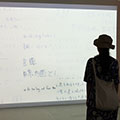
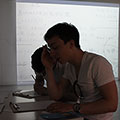
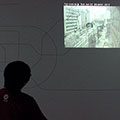
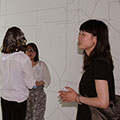
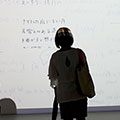
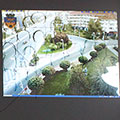
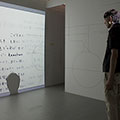
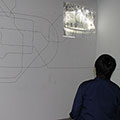
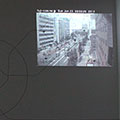
installation views
please click to enlarge
The gallery installation consists of a large projection that displays the participant’s textual responses, and a smaller projection displaying their drawings. These two projections are visually connected with a tanglement of interconnected train and subway maps, interpreted from those that the artists used to find their way throughout Tokyo during their residency.

A camera mounted overhead tracks visitor’s position within the gallery. The larger projection, which displays fragments from participant’s texts within a 16X16 grid, responds to the visitor’s location. Visitors quickly learn the works’ simple, direct method of interaction: the most active area of the projection’s grid corresponds to the position of visitor(s) within the gallery in a 1:1 spatial ratio. Thus, when a visitor occupies the left/front-most area of the gallery, the left/top-most area of the grid is active. “Inactive” areas of the grid are static and their content fades into a gray wall of handwriting. “Active” areas rapidly flicker through small fragments of participant’s responses from a database. The simplicity of this interaction - its one-to-one correlation and relation to familiar mapping techniques - belies a contradiction: the active area, while the most visually stimulating, is also the most unstable and confusing for visitors to actually read and understand.
A smaller projection, situated high up in a corner of the gallery, displays the participants’ drawings displayed in a linear sequence and superimposed over real-time feeds from IP webcams located around the world. The webcam feeds depict a bewildering array of specific views from unknown locations, some with expansive views and others confined; some depicting densely-populated areas and some utterly vacant; some in the middle of the day and others in the pitch-darkness of night. Over these images are layered the participants’ drawings, reflecting the nonlinear nature of memory: a forgotten experience might suddenly be recalled in an unexpected place.
Connecting these two separate projections are a series of wall graphics that trace Tokyo’s complex and layered rail systems, but with station markings and names removed. For any Tokyo resident or visitor, these systems are a crucial means of negotiating the city. As in most other urban centers, Tokyo’s public transportation infrastructure forms a crucial aspect of everyday life, and, to a large extent, dictates the specific comings and goings of millions of people on a daily basis.
© 2013 Sala Wong & Peter Williams